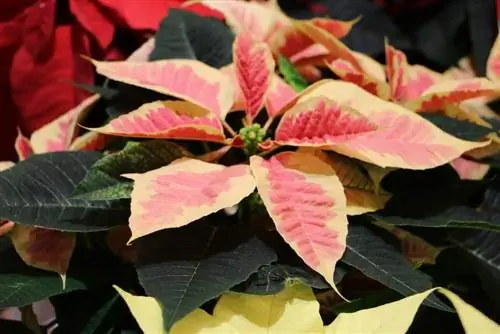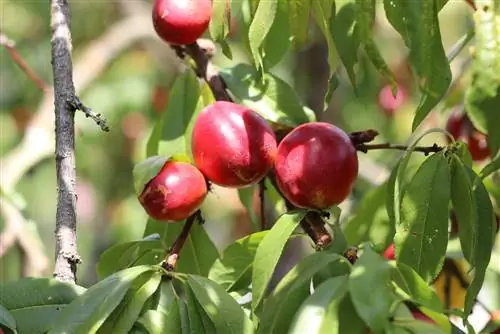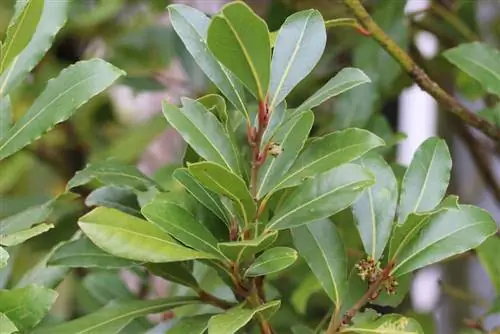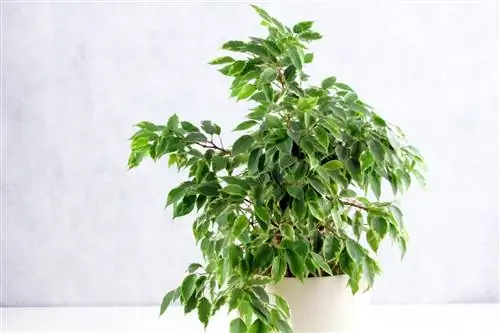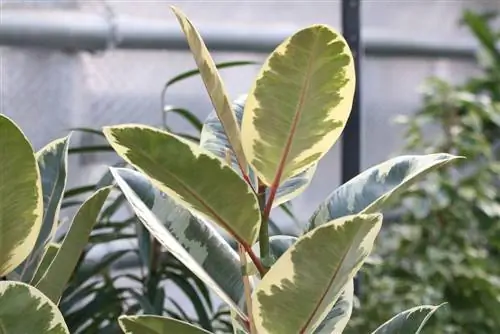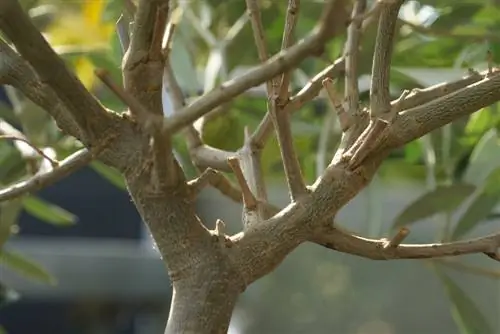- Author admin [email protected].
- Public 2023-12-17 03:39.
- Last modified 2025-01-24 12:45.
Poinsettias are often “treated quite unfairly” - only shortly before the sale did the poinsette unfurl its magnificent red leaves, making the whole family happy about Christmas, but immediately after the celebration the poor plant ends up in the trash can. The poinsettia would also like to start spring and continue to grow, and you can even turn the poinsettia leaves red again in time for the next Christmas; You can find out how to do this in the article
Poinsettias are permanent tropical plants
The poinsettia originally grew in tropical deciduous forests in South America and Mexico, where it was quickly discovered as an ornamental plant and exported to other tropical/subtropical regions. The beautiful bushes now also decorate parts of Africa, Asia, Australia and many warm Mediterranean countries, often in larger populations, even in the wild. No wonder, in subtropical or warm Mediterranean climates, the poinsettia grows into meter-high bushes, up to four meters high are possible. At the time when the whole plant shows more red than green on the outside, a truly magnificent sight.
However, it takes a few years for the bushes to reach such a size - which would not be desirable for us because the poinsettia cannot tolerate temperatures below 0 °C, so it can only be cultivated as a houseplant. The botanically named Euphorbia pulcherrima (in 1833 by the director of the Berlin Botanical Garden) is a species from the genus Euphorbia and the spurge family Euphorbiaceae. These spurge plants are distributed in around 240 genera with around 6000 species throughout the world, from temperate to tropical areas, but have only developed large tree and shrub forms in very warm tropical climates.
In their homeland, older branched poinsettias bloom almost all year round, but the main flowering period naturally begins in November, brightens up Christmas and lasts until January or February. As the keyword “older” suggests, these poinsettias are not disposed of after the festival, but rather produce the splendor of flowers every Christmas for many years.
Tip:
It is true that the decorative red leaves are not flowers, but rather strikingly colored bracts. But this detail is actually not important: the large bracts are inseparably connected to the actual - green-yellowish, small, inconspicuous - flowers, because the decorative or bracts of the euphorbias are only colored during the flowering period and only around the flowers become. These bracts are only so beautifully colored because they have taken on a task that the flowers of most spurge species, which are reduced to the bare essentials, do not perform well: attracting insects for pollination. When it comes to getting the poinsettia's bracts to turn nice red again, it's actually about getting the poinsettia to bloom at exactly this time.
The poinsettia and temperate climates
Because the ornamental value of the plant is so unique, breeders have been working for a long time to develop small specimens. As you know, they succeeded in doing this a long time ago, and we trade the results around eight weeks before Christmas until shortly before the festival. This was initially not the case when the poinsettia was brought to Europe in Alexander von Humboldt's luggage at the beginning of the 19th century. The tropical plant ended up in our botanical gardens and was observed, but was probably quite disappointing at first because it didn't even think about developing beautiful red leaves (or even blooming) shortly before Christmas.
Because there is a special mechanism behind the main flowering period from November to February:
- Euphorbia pulcherrima are short-day plants
- These plants only produce flowers if they receive less than 12 hours of light per day
- This makes sense at the natural sites not far from the equator
- Autumn/Winter is the only time when there is bright sun for less than half of the day
- For a large-leaved plant with huge evaporation in hot climate, the best time to bloom
- The first European cultivars of the beauties didn't know this
- Obviously not others either, the poinsette only became popular in California at the beginning of the 20th century, when German emigrants promoted it to the “Christmas Star”
- So in a climate where the bracts turn red at Christmas without any manipulation
- Because e.g. For example, in California City, daylight will be available from October 1st. falls below 12 hours

In the course of breeding compact indoor forms, the breeders/gardeners also discovered the trick with the short days: In the Central European nurseries where the poinsettias are grown in greenhouses, the plants are darkened from the beginning of October; Depending on the location of the greenhouses, by operating the main light switch in the corresponding hall or artificially with dark foil.
Turn the poinsettia red again
If you have “oversummered” the poinsettia at home, you don’t actually have to do anything to “miss” it a dark period of at least 12 hours if it were outside: In Berlin, which is to the north, we have it from the 26th September less than 12 hours of daylight, in Freiburg, located to the south, from September 25th. But it's not outside, at least not for long because of the cold, and there aren't 12 hours of darkness inside. Our apartments are bright, especially in the evenings after work; and even if the bedroom is only used for sleeping, it is illuminated for an hour or a lot longer for books/television.
So the poinsettia still gets “red Christmas leaves” on time:
- If a room is available that is dark from early evening, the poinsettia will move there at the beginning of October
- If not, from this point on it will be covered opaquely for at least 12 hours a day
- With a bucket, a box, solid dark foil, thick dark fabric
- Really opaque, even weak light in the dark phase can prevent flower formation and bract coloring
- For a good 6 weeks, the poinsette should be darkened for half the day so that flowering is safely induced
- If the covering is carried out consistently every day from October onwards, colored bracts will appear just in time for the festival
- The balcony or terrace would be perfect locations from the end of September until the temperatures fall below 14 °C
- There too, you can only save yourself from having to cover and uncover it for a while when it is dark in the evening
- This is rarely the case because these “open-air rooms” are almost always lit from the inside
- If it is not covered, the tropical plant needs a very warm and bright location.
Tip:
If you want a poinsettia to live longer with you, you should make sure that the plant shows good potential when purchasing it. The poinsette's bracts should already show color, delicate or strong red depending on the date of purchase, and the poinsettia should already show more or less developed flower buds (yellow-green and buds, "hidden" between the colored bracts). Don't buy from outdoor stalls when it's cold outside, poinsettias can suffer damage from temperatures as low as 10°C on a market day. Think about warm transport packaging if the poinsettia has to be transported through the cold.
Proper care must be natural
If the poinsettia is to be “oversummered”, it needs good care before and after Christmas:
- Cultivate from purchase until spring at room temperatures of 15 to 20 degrees in a bright location
- Draughts at the location or a place directly above the heater are poorly tolerated
- Watering moderately, preferably with water at room temperature
- Remove water from the coaster after approx. 15 minutes.
- Or dip instead of pouring and let it drain well
- Reduces the risk of waterlogging even more, Euphorbia pulcherrima doesn't like waterlogging at all
- Do not fertilize pre-fertilized commercially available poinsettias until and during the flowering period
- Home-grown poinsettes get some fertilizer in their water once or twice a week during the flowering period
- Prune for the first time in April and shorten it by around a third
- All faded bracts and flowers also fall
- If necessary, transplant it into a larger pot now
- Then place it outdoors if possible
- Not in the full midday sun, but sunny
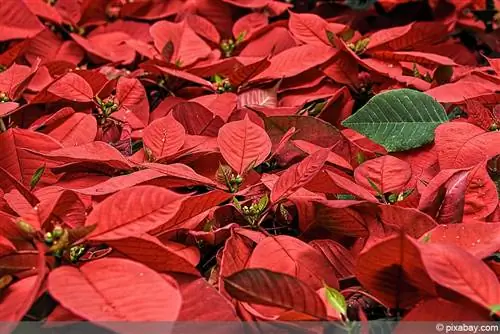
Green leaves grow back all summer long, but the color only comes back after the special treatment described above. If the plant has been in the dark for at least twelve hours a day from October to mid-December, you should not suddenly expect it to have 16-18 hours of light a day. Over a few days, uncover the plant more and more and gently acclimate it to a possible new location in the Christmas room.
Poinsettes can get old
If a poinsettia is cared for well, it can stay with you for a long time. You can influence longevity when purchasing - varieties with dark foliage are said to be longer lasting than light foliage. Light-colored foliage can occur not only because a cultivar develops lighter foliage, but also because it is grown too quickly in a greenhouse. In terms of longevity, such poinsettias are not recommended either (you can be happy if they last through the holidays).
Later, the most important thing is that you do not prune the poinsettia excessively, which happens more often for good reason: the poinsettias in stores should be as compact and dense as possible when sold, and root cuts are usually made on the young plants, the young plant usually also gets a growth inhibitor in the water. These influences will grow out at some point, the more optimally you care for the poinsettia, the faster, and then you will have a tropical plant that is happy to grow and can really get started. You shouldn't remain idle for long: If your poinsettia starts growing like crazy after a while, you should almost stand by with the scissors to point this growth in the right direction. From then on, a vigorously growing poinsettia can best be trimmed a little in spring and autumn to keep it in shape.
“Summer Poinsettias”
Breeders are imaginative and keen to experiment, which is why these days there are no longer just the rich red Christmas stars. Rather, you can purchase cultivars of Euphorbia pulcherrima that “bloom” pink, lemon yellow, creamy white, burgundy, pink, apricot or rosé, bicolor marbled or multicolored variegated; and new cultivars come onto the market every year. A little foretaste of the varieties:
- Euphorbia pulcherrima ‘Barbara Ecke Supreme’ shows bright red bracts
- E. pulcherrima ‘Ecke’s White’ turns the bracts into an elegant creamy white
- E. pulcherrima ‘Rosea’ shows a kind of pale pink with dark highlighted leaf veins
You can hardly get such beauties at the mass-produced goods seller around the corner; they have poinsettias in red and in the fashionable color of the season (and if they are blue, black or turquoise, they are artificially created with plant-friendly varnish). You can find poinsettias in unusual colors in nurseries or from breeders who specialize in euphorbias; you can find such nurseries and breeders through tips from a specialist nursery or of course on the Internet.
Since our summer offers the poinsettia approximately the same temperatures that it has in its homeland during winter flowering, you can gradually switch the plant to summer flowering. The short-day plant simply needs day lengths of less than twelve hours to start flowering, in our climate that does not meet its requirements anyway, it can also be darkened later in the fall and then in the winter. If you have pulled the end of the six weeks of coverage into early summer, it will bloom Poinsettia in summer, not only suitable for pink-flowering Euphorbia pulcherrima.
Conclusion
If you have said goodbye to the unecological, needle-throwing real Christmas tree or are planning to do so, the poinsettia offers the possibility of a really exciting alternative: place many poinsettes on a cylinder that tapers towards the top (geometrically cone or cone, “Christmas tree-shaped”. "(or self-made from a sturdy cardboard / plastic material with holes for hooks), the red splendor will "represent" the Christmas tree so well without or with Christmas tree decorations that visitors will be amazed with their mouths open. A bit much and a bit expensive? Grow the many poinsettias yourself; Euphorbia pulcherrima can be easily propagated from cuttings. Or you can save the plants from the nearest public compost bin - around 32 million poinsettias are sold every year and most of them are thrown away after the festival.

